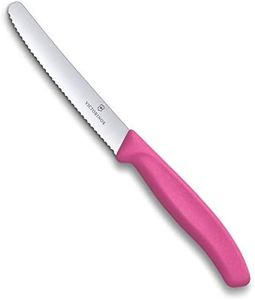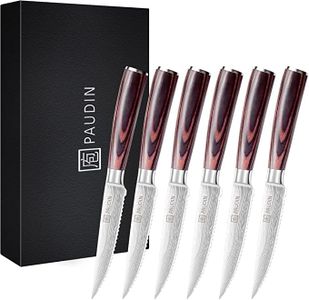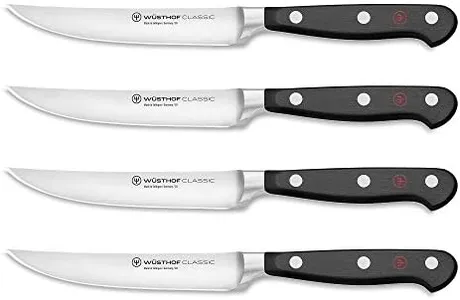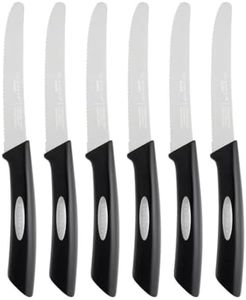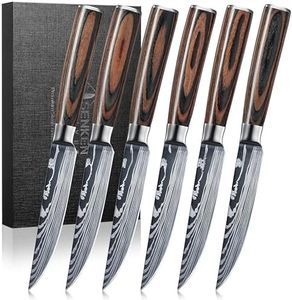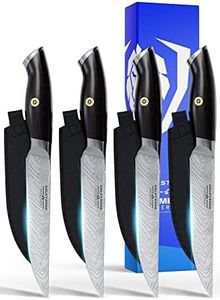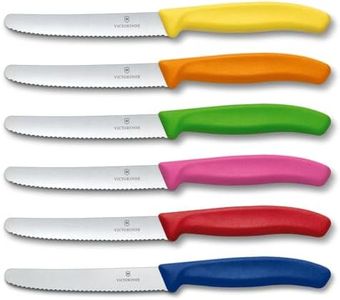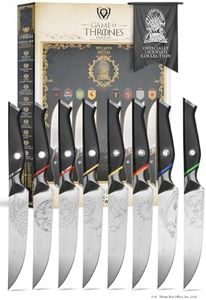We Use CookiesWe use cookies to enhance the security, performance,
functionality and for analytical and promotional activities. By continuing to browse this site you
are agreeing to our privacy policy
10 Best Steak Knives
From leading brands and best sellers available on the web.Buying Guide for the Best Steak Knives
Choosing the right steak knives is about finding a balance between comfort, cutting performance, and lasting quality. Steak knives play an important role in dining experiences, making it easy to slice through meat with minimal effort and enhancing both presentation and enjoyment. Before buying, think about how often you'll use them, your preferred style, and how much maintenance you're willing to do. Always consider how a knife feels in your hand and pay attention to the core qualities that affect usability and durability.Blade MaterialThe blade material determines how sharp, durable, and rust-resistant the steak knife will be. Common materials include stainless steel and high-carbon steel. Stainless steel is popular because it resists rust and staining, making it easy to care for, while high-carbon steel can maintain a sharper edge but requires more maintenance to avoid rust. For most people, stainless steel offers a good mix of performance and low upkeep, making it ideal for everyday dining. If you're passionate about ultimate sharpness and don’t mind careful cleaning, high-carbon steel might appeal to you.
Blade EdgeBlade edge refers to whether the cutting edge is straight (plain) or serrated. A straight edge gives cleaner, precise cuts and can be re-sharpened easily, making it suited for those who want a traditional kitchen-like experience. Serrated edges, on the other hand, are great for sawing through tougher meats without tearing, and they stay sharp longer but require special sharpening tools. If you’re looking for low maintenance and quick slicing, go with serrated. Pick straight edge knives if you prefer a smooth cut and are comfortable with sharpening.
Handle MaterialThe handle material affects comfort, style, and how much care the knife needs. Popular materials include wood, plastic, and composite (like resin-infused wood or polymers). Wood handles feel warm and look elegant but need to be hand-washed and dried to avoid cracking. Plastic and composite handles are more durable and dishwasher safe, making them great for daily use and easy cleaning. Choose wood if you value aesthetics and tradition, or synthetic handles for practicality and ease of care.
Balance and WeightBalance and weight impact how comfortable and effective the knife feels during use. Heavier knives tend to cut through meat more easily by leveraging their own weight but can tire your hand if used for long meals. Lighter knives offer more control and agility but may require more force. The right choice depends on your preference—if you like a substantial, solid feel go heavier; if you want quick handling and reduced fatigue, lighter is better. Testing how a knife feels in your hand is always best.
Tang ConstructionTang refers to the part of the blade that extends into the handle. Full tang means the blade and handle are a single continuous piece, offering maximum strength and balance. Partial tang knives have the blade only extending partway into the handle, which is less sturdy. Full tang knives are ideal for frequent use as they feel more solid and last longer, while partial tang can be fine for occasional or decorative use.
Ease of CleaningHow you clean your steak knives affects both their longevity and your convenience. Some steak knives are dishwasher safe, especially those with stainless steel blades and synthetic handles, making cleanup simple. Knives with wood handles usually require hand washing and immediate drying to prevent damage. If you want maximum convenience, look for dishwasher safe options, but for best longevity—especially with premium knives—hand washing is often recommended.
